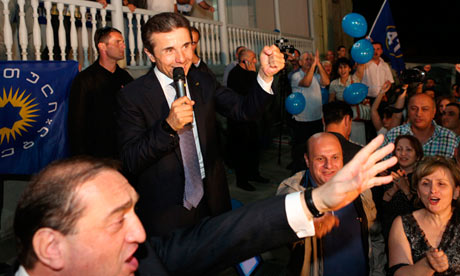
Questions Linger on Voter Behavior in Georgia’s Elections
Publication: Eurasia Daily Monitor Volume: 10 Issue: 48
By:

Georgia’s October 2012 parliamentary elections amounted to a plebiscite on the policies of Mikheil Saakashvili’s government. Voters responded by giving his rival Bidzina Ivanishvili’s Georgian Dream 85 parliamentary seats, against Saakashvili’s United National Movement (UNM), which gained 65 seats in the 150-seat chamber. The votes cast were 55 percent for Georgian Dream versus 40 percent for the UNM in the contest among party lists, which compete for one half of the parliament’s seats. Reflecting intense voter polarization, only these two political forces entered the new parliament. On the other hand, the voter turnout of 60 percent indicated indifference among a large part of the electorate, despite the highly charged political atmosphere.
Whether those scores represent the electorate’s considered judgment of the UNM government’s performance, or whether the UNM could have legitimately won, are not questions beyond debate. The UNM had been ahead in opinion surveys, such as the National Democratic Institute’s (NDI) (which Georgian Dream contested; see Civil Georgia, September 5, 7, 2012), until the prison torture scandal intervened 12 days before election day (Civil Georgia, September 22, 26, 2012). By all accounts, this event caused some previously undecided voters to elect Georgian Dream, and some UNM supporters to refrain from voting or switch to Georgian Dream. Yet, irrespective of this scandal’s distorting impact on the endgame, it is clear that very large portions of the electorate disapproved of the government’s policies or were indifferent to its performance.
Georgian Dream mobilized blocs of discontented voters, who lost directly or indirectly from the post-2003 reforms, or found it difficult to use the new opportunities, or who live in still-undeveloped parts of the country with high unemployment. Such voter blocs include: the former regimes’ (late-Soviet and Eduard Shevardnadze-era) beneficiaries, e.g., former administrative-bureaucratic personnel in Tbilisi and other towns, former police dismissed en masse, large numbers of petty traders in the semi-legal economy suppressed since 2003 (each one of these categories includes many tens of thousands of families); voters in large parts of the rural countryside that have been left out of modernization processes thus far; and voters hoping that the billionaire Ivanishvili could extend his social paternalist system from his own native district to the entire state, if he came to power. Another massive anti-government voter bloc consists of relatives of tens of thousands of common-law criminals, imprisoned thanks to the government’s “zero-tolerance” policy against crime.
The UNM lost all the electoral districts in which the government had concentrated domestic and foreign investments most heavily. Targeted investments lifted such areas from the condition of Soviet ruins into the modern age within only a few years (2004–2012). Nevertheless, the UNM lost Adjara with Batumi (despite its booming hotel economy, sea port and international airport), Kutaisi (despite massive construction projects, including a new parliament building and international airport), Svaneti with Mestia (where international ski resorts and modern transport infrastructure were brought to a pocket of pre-Soviet backwardness). The UNM also lost Tbilisi despite the city’s fast development under UNM aegis.
No satisfactory explanation has been adduced as to why the UNM lost the districts that experienced the fastest progress in the country. The explanation from Georgian Dream circles, namely that those inhabitants “did not feel the benefits” of infrastructure and job creation, seems no more rational than voters’ own behavior in those areas. In Adjara, for example, Georgian Dream won by fomenting anti-Turkish sentiment over Turkish investment projects and the restoration of a historic mosque in Batumi (The Messenger, March 7, 2012; EurasiaNet, September 19, 2012).
The UNM won in its traditional stronghold of Samegrelo and also carried the Azeri-populated and Armenian-populated districts, which routinely vote in favor of any incumbent Georgian government. Samegrelo’s staunch pro-UNM vote since 2003 stems in part from the sentiment that Saakashvili had somehow restored political justice by ousting then-President Eduard Shevardnadze, who had earlier defeated ex-president Zviad Gamsakhurdia whose Samegrelo roots made him popular there.
Those areas have experienced far less investment and development, compared with other parts of Georgia under the UNM government (see above). Nevertheless, the relatively deprived areas voted for the UNM again in October 2012. This recalls the January 2008 presidential election. At that time Saakashvili won re-election with 53 percent of the votes cast country-wide, but with heavy majorities in Samegrelo and in the Armenian and Azeri districts. That lifted Saakashvili over the top country-wide. The October 2012 parliamentary elections repeated that pattern, albeit with reduced majorities for the UNM among Armenian and Azeri voters, and amid a country-wide victory for the opposition.
These elections saw for the first time the intervention of Orthodox clergymen into politics. Some low- and medium-ranking priests urged voters to elect Georgian Dream while attacking Saakashvili and his government’s policies as heretical, depraved, and hostile to Georgian traditions and national identity. Some priests delivered this type of message in church sermons while others spoke at Georgian Dream campaign rallies. Although such episodes were not pervasive, and the outspoken politicized priests formed a minority among the clergy, television coverage helped magnify their impact on the electoral campaign (https://netgazeti.ge/GE/105/News/12800/).
The Church’s top hierarchy maintained political neutrality, and Patriarch Ilia II twice publicly urged the clergy to avoid supporting either party. The admonition seemed to have little effect, however. Parts of the clergy associate Saakashvili’s government with the advent of secular liberalism, cosmopolitanism and Western ways of life to Georgia. The Church as a whole claims to protect social mores and national traditions from those perceived corrosive influences. In this respect the Church feels clearly more comfortable with Ivanishvili—all the more as he has generously financed Church projects. The hierarchy also shares Ivanishvili’s priority goal to improve relations with Russia.
Opinion surveys show the Orthodox Church as by far the most respected among all of Georgia’s public institutions. Its low- and medium-level clergy have now directly entered the political arena. The top hierarchy’s shine will undoubtedly reflect on Ivanishvili as the leader of government. A de facto alliance between government and the Church is taking shape, marking another step back from the Western-style liberalism that became possible in Georgia during the Saakashvili era.




